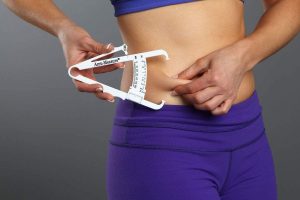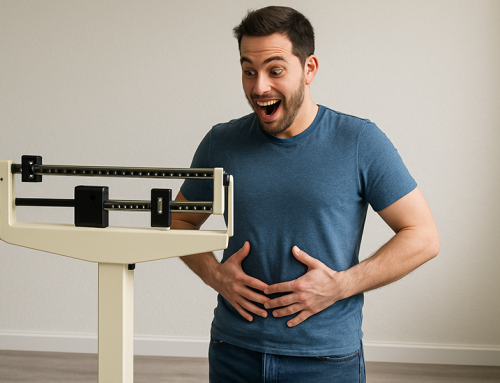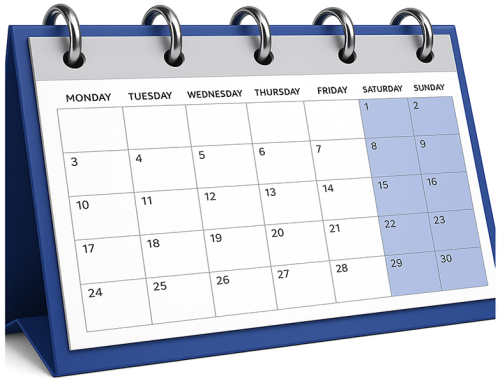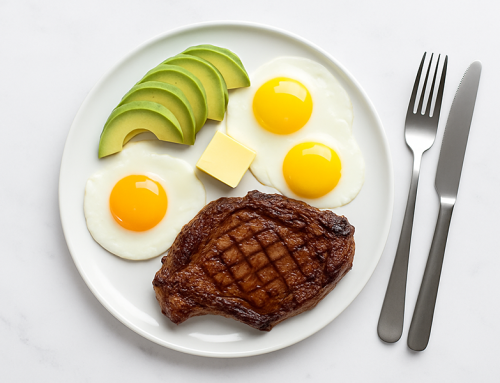Is it really necessary to measure your body fat to ensure fat-burning and muscle-building progress? Some experts today are starting to suggest that we throw away our body fat calipers, just as others in the past have told us we should “throw away our scales.” Should we listen, or would that be making a huge mistake? Find out the answer in this week’s Burn the Fat Blog “Ask Tom” Q & A…
Q: Hey Tom, I recently read an article online by a well-respected trainer saying that it’s not necessary to measure your body fat. The main argument was that it’s how you look that counts, and if you tune-in to how you look from week to week, and ultimately, if you like how you look, then it really doesn’t matter what your body fat percentage number is. A secondary argument was that body fat testing is not accurate, so your results are often wrong. All things considered, the author said body fat testing is a total waste of time and you should throw away your body fat calipers and scales because they will only mess with your head and cause discouragement and frustration. Your thoughts?
 A: This is a good question. I read the article and the author made some legitimate points. However, I was a bit dumbfounded to hear him say body fat testing is a “Total waste of time” and “Throw away your skinfold calipers.” It almost made me wonder if he was being sensationalist just to stir up controversy and get attention.
A: This is a good question. I read the article and the author made some legitimate points. However, I was a bit dumbfounded to hear him say body fat testing is a “Total waste of time” and “Throw away your skinfold calipers.” It almost made me wonder if he was being sensationalist just to stir up controversy and get attention.
We should certainly use how we look to track progress, and body fat testing does have potential margin for error. But body fat testing is well-established as a reliable and valuable tool for tracking progress as well as staying accountable.
With that said, my short answer is, no, it’s not absolutely mandatory. There are plenty of people who make great progress without body fat testing, including myself, at times.
Who Could Benefit From Body Fat Testing The Most… And Why… And When?
I used to have my trainer measure me regularly with a 4-site skinfold test and I knew it was accurate because he was an expert tester. These days I get tested only when I’m working on an important goal when I want to reach peak condition in a certain time frame, and periodically I get tested for an accountability check or to establish a baseline at the start of a new goal or training phase.
Why do I tell other people to measure body fat weekly or at least every other week when I don’t do it all the time myself anymore? It’s because I have no trouble monitoring my progress visually. I can even get a good sense of how I’m doing by grabbing (palpating) skinfolds with my bare fingers (not a caliper). I get good feedback by feel, without even knowing the exact thickness in millimeters or the exact body fat percentage.
I recently completed a muscle-building phase (aka “bulking”) and while I made some solid gains, I knew my body fat had gone up slightly from the upper single digit levels I used to maintain. But I hadn’t tested my fat percentage – I knew this just by looking in the mirror.
Then I decided I was going to play, “guess my body fat.” I took a good look at myself in the mirror and pinched my abdominal and illiac skinfolds with my fingers, and I estimated my body fat as “definitely over 10%, but probably under 11%.” I then did a skinfold caliper body fat test and it put me at 10.9%. Not a bad guess, right?
So I can agree with the author of the article that it’s entirely possible to track progress without body fat testing and even reach a point where you can estimate your body fat and be pretty close.
Here’s the catch: It took me years of experience to reach that level of sensory awareness where tracking progress – especially small week-to-week changes – and dialing myself in became easy just by looking in the mirror and grabbing the skin on my abs. Most people aren’t there yet.
Beginners haven’t developed their intuitive sense highly enough to know at a glance whether their body fat is going up or down week to week, let alone day to day. Beginners don’t have a concept yet of what is a good body fat level and what is an unacceptably high body fat level. Beginners don’t know what various body fat levels look like on their bodies. Beginners don’t know how much body fat they would have to lose to see their abs and good all-over muscle definition. Put simply, beginners are not educated about body fat.
This is why I believe that almost everyone would benefit from measuring and tracking their body composition at least once in the early stages of their learning curve. Later on, as your knowledge and experience grows, the testing and tracking becomes optional. If you stop, you can always start doing it again if you decide to pursue an important goal.
If you track your weight and body composition numbers through at least two complete goal cycles – fat loss and maintenance (or muscle-building), you will discover things about how your body responds to nutrition and training and how to troubleshoot progress plateaus, that you cannot learn any other way.
I had my body fat measured consistently for years in the early days of my career, and the education I got about body composition and how my body responded to training and nutrition changes was priceless. It was similar to the way I did all my meal plans by the numbers on spreadsheets when I first started. I wouldn’t be able to adjust my nutrition so instinctively today if I had never tracked calories and macronutrient in the beginning.
Required Knowledge: Body Fat Versus Body Weight
What you’ll learn by measuring your body fat, weighing yourself and tracking your progress for an extended period of time is the importance of body composition – the ratio of fat to muscle in your body – and how training and nutrition affect it.
Even if you decide not to measure and track your body composition, what I consider essential to your success is that you understand body composition on an intellectual level: The big idea you must internalize, to the point that it influences every choice you make, is that weight loss and fat loss are NOT the same thing.
This may seem like a ridiculously obvious point, at least to advanced trainees or to anyone who has read the Burn the Fat, Feed the Muscle book. But for most typical dieters, body composition is not even on their radar.
This is Burn the Fat, Feed the Muscle 101: Weight loss is not always fat loss, and therefore weight loss is not always a positive outcome. Weight loss can include water, glycogen, the contents of your digestive system and muscle tissue. If you lose muscle weight, you are working against yourself.
Burn the Fat, Feed the Muscle 101 continues on the flip side: Weight gain is not always fat gain and therefore weight gain is not always a negative outcome. Water weight can fluctuate dramatically day to day. And of course, if you gain weight in the form of muscle, that’s a positive outcome.
Although it’s ideal to measure your body composition, simply having this new knowledge about the difference between body weight and body composition is enough to help start changing behavior.
For example, once body composition and the importance of muscle is on your radar, you will know that diet alone is a bad idea, because diet without training leads to greater losses of muscle when you’re dieting in a deficit.
This revelation is enough to get many people to start resistance training for the very first time, and from the day you pick up your first weight and lift it, your results and health will automatically improve from that point forward. It’s a watershed moment.
Business, Sports – And Fitness – Wisdom: What Gets Measured Gets Improved
Aside from the education you get about body composition versus body weight, why else would you want to measure body composition? Motivation!
Motivational psychology 101 says, what gets measured gets improved. In any organization, whether business or a sports team, the instant that performance is measured and tracked, performance starts improving. It’s all about accountability!
I understand that you can track progress visually, but motivational psychology 102 says that the more types of feedback you have, the better. Why not track visually and by the numbers? Doesn’t it make sense that seeing how you look in the mirror and in photos, combined with weight and body composition data has more value than one or the other by itself?
In fact, it’s a visual assessment and the body comp numbers put together that help you sort things out when your results from one or the other don’t make sense based on how hard you think you’ve been training and dieting (an experience that can make you feel like freaking out.)
What About the “Head Trip?”
Someone may believe that the numbers from the scale and body fat calipers can mess with your head and leave you frustrated and discouraged. That may be true sometimes (if you let them), but so can the mirror.
Any serious fat loss diet is a head trip for most people regardless of which way they track their progress. When you consider how common it is to have a distorted body image and how tough the mental game is while dieting, I think it’s fair to say the mirror can play tricks on you just as often as the scale.
That’s exactly why I think it’s helpful to have both visual and numerical ways to track progress, and not rely on the mirror or body fat tests alone. Even better, have someone else involved in your progress tracking as an accountability partner or coach, then you have an objective observer with a clear head helping you.
To use weigh-ins and body fat tests without the process turning into an emotional roller coaster, you need to understand that strange numbers or results are bound to show up from time to time due to testing error or natural body-weight fluctuations. There will also be good weeks and bad weeks based on your compliance rate and life circumstances.
A simple re-frame in your mind helps you handle the ups, the downs and the uncertainties: If you had a result you didn’t want one week, you look at it as feedback, not failure.
Think of your numbers as a navigation system, like one you’d find in an airplane or rocket. When your progress feedback shows that you’re not heading in the right direction, that’s not a failure, that’s simply a signal to make a course correction. If a pilot quit every time a plane was slightly off course, no one would ever get anywhere.
Some people get frustrated and angry if they’re not heading in the right direction 100% of the time. But people successful at body transformation understand that like an airplane, it’s normal to get knocked off course occasionally.
Successful people don’t even worry about one week off course. They simply change their approach, increase their compliance and get back to work. They don’t worry about an odd one-week fluctuation in weight or body fat. They focus on their long-term goal and their progress trend over time without obsessing over what was little more than statistical noise.
If you look at things the way successful people do, the scale or skinfold calipers will never leave you freaked out or frustrated.
Is Body Fat Testing Inaccurate?
Let me also address the question about whether body fat testing is inaccurate, and therefore “you should not bother,” because this is an important point.
It’s true that most body-fat testing methods have an inherent potential for error. For example, the margin for error in skinfold testing may be on the order of plus or minus 3% or so. However, that shouldn’t bother you because many body fat testing methods, including skinfold calipers, have been researched and found to consistently produce repeatable results. For tracking week to week progress, it’s not the absolute accuracy, but the consistency from one test to the next that matters the most.
Where additional error often gets introduced is in the hands of the tester. An inexperienced person can not only expand the margin for error, but also produce inconsistent results, if they use inconsistent testing technique. This can be reduced or almost eliminated with experience. So, while inaccurate test results are very possible, I don’t think this is a reason to dismiss body composition testing altogether.
What if You Don’t Have Access To Body Fat Testing or You Simply Don’t Want to Measure Your Body Fat? (Do THIS Instead):
If you’re one of those people who – for any reason – does not want to track body composition, or if you have a hard time getting an accurate body fat measurement so the whole endeavor is driving you crazy, then here’s my suggested alternative:
First, at the bare minimum, take to heart the advice I gave above about understanding body composition. Muscle weight vs fat vs weight: make sure you understand this concept thoroughly.
Then, consider weighing yourself once a week for an “official” progress report. Monday is a good day because it helps keep a lot of people in check over the weekend. In addition, get a measuring tape and measure your waist size (women may also want to measure hips too).
Your waist measurement correlates highly with your body fat percentage. Although the circumference in inches or centimeters won’t tell you your exact body fat percentage, if your waist size is going down, you can almost always be assured that your body fat is going down, so waist circumference is a good proxy for body fat.
What’s more, waist measurement is a scientifically-proven benchmark for metabolic and cardiovascular health risks.
Metabolic syndrome is a cluster of symptoms that are linked to risk of diabetes and cardiovascular disease. One of the risk factors is abdominal circumference of 35 inches or more for women or 40 inches or more for men. That makes the waist size / abdominal circumference measurement a good one to monitor for both health and body fat tracking reasons.
Track these numbers, and combine that feedback with an assessment of how you look in the mirror every week, and you should have no difficulty navigating your way to your goal without a body fat test.
Concluding Advice
One last caveat: Don’t become obsessed with pursuing any specific body fat number, thinking that it’s some kind of “holy grail” achievement.
It’s true: The body fat percentage number really doesn’t matter if you are happy with the way you look. Also keep in mind that two people can look completely different at the same body fat percentage – one visibly much leaner than the other. That is to say, “people wear their body fat differently.”
But measuring the change in the numbers and seeing your progress move in the right direction does matter. Use your body fat test results as an educational tool to understand body composition and also as a tracking tool to monitor your personal progress over time and you can’t go wrong.
To learn more, read the Burn the Fat, Feed the Muscle book, chapter 5 on measuring body composition and chapter 6 on tracking progress (“The feedback loop system that won’t let you fail”): Buy now on amazon OR if you already have the book, check out the Burn the Fat Inner Circle community for ongoing support and continuing education at www.BurnTheFatInnerCircle.com
– Tom Venuto
Tom Venuto is a natural bodybuilder, fat loss coach, fitness writer and author of Burn The Fat, Feed The Muscle. Tom’s articles are published on hundreds of websites worldwide and he has been featured in Muscle and Fitness, Men’s Fitness, Oprah magazine, The New York Daily News, The New York Times and the Wall Street Journal. He has appeared on dozens of podcasts and radio shows including Sirius XM, ESPN-1250, WCBS and Day Break USA. Tom is also the founder and CEO of the premier fat loss support community, the Burn The Fat Inner Circle.
Related Articles:
Your Scale is a a Liar, But Don’t Throw It Out
The Ultimate Guide To Skinfold Calipers And Body Fat Testing
What is the Necessary Body Fat Level To See Your Abs (Members-Only Area)
What Is A Healthy And Realistic Body Fat Loss For A Week? (Members-Only Area)
How To Measure Your Body Fat In the Privacy Of Your Own Home e-book (Members-Only Area)







Great article, Tom. I’m so glad you are posting regularly again!
As someone who has been both elated and disappointed with their body fat tests, I can relate to a lot of what you’ve written here. I’ve also learned a lot over the last two years of testing.
Two things in particular that stand out for me.
1. I’ve learned to focus deeply on the lean body mass (LBM) number, and less about the fat percentage itself.
2. Chasing specific body fat levels can leave you underwhelmed.
I quickly learned that the number you really want to care about when body fat testing is the lean body mass. If you are in a hypertrophy phase, increases in LBM signal tangible progress. And likewise, if you’re cutting, tracking retention of your LBM becomes the primary goal.
In my most recent bulking phase, I managed to keep increases in LBM ahead of body fat increases, with over 50% of gains coming in LBM. And when it came to cutting the excess fat, I shed over 8lbs of fat while dropping less than a pound of LBM. THIS is why body fat tracking is useful… especially if you are using the same technique (and/or practitioner) regularly.
In your post, your wrote this, Tom:
“Don’t become obsessed with pursuing any specific body fat number, thinking that it’s some kind of “holy grail” achievement.”
Again, I can really relate to this. In my last cut, I had set my mind to reaching 180lbs @ 9% body fat, and chased it down pretty successfully. I came in at 179.25lb and 9.01% body fat. But here’s the rub, I didn’t look how I thought I’d look. Despite good overall leanness, the abs were still sloppy and I was kind of disappointed when I should have been really pleased with the outcome. I perked up eventually, but it goes to show, that chasing body fat levels can definitely be misguided.
Keep up the great work, Tom!
Thanks Paul!
I think that the occasional hydrostatic body composition test is useful. Skin calipers cannot pick up on visceral fat in the abdomen. I’ve seen lots of people who are “skinny on the outside” but “fat on the inside”.
If calipers tell say you are 10% body-fat but the dunk tank says you are at 15% then you know you might have a problem to check into,
I have a question. I recently picked up a bowflex max trainer m5 and have been using it as recommended. I also downloaded the my fitness app. I have been working out and tracking calories. I have even been massing my food with a triple beam balance. I bought a scale that measures BMI and body fat percentage. I notice my weight going down, but body fat percentages have barely moved. Am I losing muscle and water more than fat or is it possible that I have a poor scale. I am slightly disappointed with the low body fat loss.